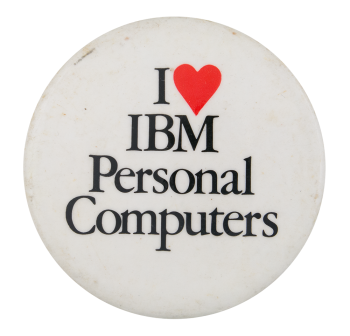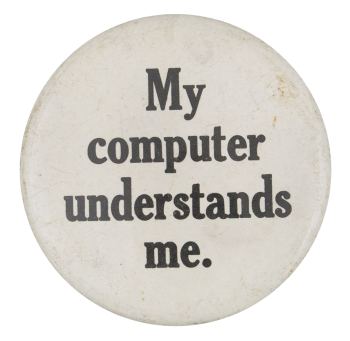#ibm computers
Explore tagged Tumblr posts
Text

ibm palm top pc 110, measuring only 158 by 133 by 33 mm (6.2 by 5.2 by 1.3 in) and weighting about 630 g (1.39 lb) with the battery inserted
5K notes
·
View notes
Text

IBM 80 column punch card - circa 1966.
#ibm#ibm punch cards#ibm computers#computers#computing#vintage computers#vintage computing#international business machines#punch cards#computer punch cards#vintage tech#vintage technology#electronics#vintage electronics#calculators#technology#engineering#computer systems
12 notes
·
View notes
Text
Okay so... this is really NOT Tiktok's fault. It would shock me if the origin of "Daisy Bell" being regarded as creepy *isn't* Kubrick's "2001: A Space Odyssey" from 1968. Here's the key scene:
youtube
(A clip from "2001: A Space Odyssey, 4:35 minutes long, of the Deactivation of Hal 9000. If this embed ever goes bad, go search for "deactivation of hal 9000" and I'm sure you'll find it.)
I'm going to guess that anyone confused on this point has not watched this movie -- which is a famous science fiction classic, but it's also famously VERY LONG, dense, confusing, and many would say, boring. It has very good special effects for 1968, and I honestly HIGHLY recommend watching it because it's a classic of the science fiction genre, influential on pop culture, PLUS, it's kind of timely right now. It arguably started the conversation about Artificial Intelligence and its capacity for being a threat, and its pop cultural influence still colors the way we think of and talk about AI today.
Yes, it's slow-paced; that's partly due to film style in 1968, and partly due to deliberate choices about how to depict time and spaceflight. But if you want a lot of pop cultural references to click into place, find a copy, block out a few hours, sit back with your favorite snacks and beverage, and just watch it, all the way through.
Anyway... the key part of the above video comes at 2:50, but it's only 4 and a half minutes long (it will feel longer! again, deliberate), and I would say that watching from the start will give you a greater appreciation of the use of the song.
Basically -- the song is used in this movie BECAUSE OF the history of the IBM 7094 described above.
The thing a lot of people don't realize about "2001" is that it's a thriller and a horror movie. In all honesty, to appreciate the atmosphere of the above clip, it really, REALLY helps to watch the whole movie. However, if you're not going to, I'll give spoilers below, under a readmore. But since the clip above spoils that key moment, what I'll say is that the Hal 9000 shipboard computer, a true Artificial Intelligence (but nonetheless, a programmed computer, and that is a key thing), is being deactivated by disconnecting various memory and higher function modules. And as Dave Bowman does that, it is depicted as kind of doing a factory reset on Hal. So, at 2:50 above, Hal is knocked back to its initial greeting to a group of scientists or government agents when he was first activated, and he offers to sing "Daisy Bell" for them. THAT is absolutely a reference to the 1961 performance by the IBM 7094.
The reason it's creepy in the context of "2001" is because we're watching Hal "die", and singing "Daisy Bell" is kind of the last vestiges of Hal's sentient personhood disappearing.
But like... I would argue that the song wasn't included with the aim of making it creepy. My read on it is that the song was included to make Hal's death poignant. (And of course, remember that in 1968, the IBM 7094 had performed "Daisy Bell" only 7 years earlier; anyone watching the movie who kept up with science news would have heard about that, and might have seen footage of it.)
"2001: A Space Odyssey" would, as I said, come to be regarded as an extremely confusing and dense film. And once films like "Star Wars" came out less than a decade later, 2001's pacing would come to be seen as old-fashioned and boring, even though it was in great part a stylistic choice. (It was a movie meant to make routine spaceflight appear realistic, and so it was deliberately overturning expectations of fast-paced action that audiences would have had from kitschy scifi TV shows... yes, including the original Star Trek.)
But, despite what I'd characterize as the ambivalence of the audience towards the film, it DID leave a big imprint on pop culture. Today, if you ask people about "2001", they will probably have a few key impressions about the movie. First: oh my god, what the fuck was that ending??? Second: the Monolith, specifically the opening scene with the proto-humans (recently parodied at the start of the "Barbie" movie! More than 50 years later!). But then, I would argue, Third: the Hal 9000 computer, and probably this sequence of his deactivation.
The whole deal with the Hal 9000 was definitely meant as a cautionary tale. The audience is meant to be disturbed by what Hal does, and by Hal's end. (Arthur C. Clarke, who wrote "2001", wrote an entire sequel book that argues that Hal wasn't at fault for what happened; and that too was made into a movie in the 80s, "2010: Odyssey Two".)
Thus, this scene got referred to in popular culture again and again. To the point where almost nobody remembers WHY Hal sings "Daisy Bell", or that history with the IBM 7094. What they remember is how a cute, innocent song takes on a creepy, unsettling edge due to its context in the movie.
As I said, I don't really think that was Clarke's or Kubrick's aim. (Clarke wrote the screenplay of "2001" first, and was doing revisions on it as the film was being made. He only wrote the novel version after the film was completed.). But that was the effect. It seized public imagination, and became a reference point. And then, as these things do, it became regarded as a truism. "Daisy Bell" becomes ominous by association, and the public really never let that go.
Anyway, as promised, here's some spoilers:
So, the briefest synopsis of "2001: A Space Odyssey", lol:
(Short version: the Hal 9000 is the ai computer helping to run a spaceship on a mission to Jupiter. Hal winds up killing 4 of the 5 crewmembers, and tries to kill the 5th. Dave Bowman, the 5th crewmember, manages to fight back and deactivate Hal to save his own life. There are... reasons for all of this. Read on!)
There's this black Monolith, a featureless rectangle that is 1:4:9 (it's 11 feet high). We first see it in a dusty, desert landscape, surrounded by what appear to be apes, although it's also kind of clear that they are early hominids. (I'm not sure exactly what type; like, kind of like Australopithecus, but not that, exactly.). The early hominids are curious about the Monolith, and work up the courage to touch it. It makes an eerie noise. Soon after, one of the hominids pics up a large bone, and uses it to hit other things (and fellow hominids). The message: likely due to some influence from the Monolith, hominids have taken a developmental step in the direction of tool-use.
Millions of years later, in the near future, a man takes some routine spaceship flights to a moon base, on a top-secret mission. The secret is that U.S. explorations on the moon have excavated a Monolith, just like the first one. It's just sitting there. But it's very clear that it's not natural, so of course, the question is: where did it come from? Who put it there? The men all put on spacesuits and walk down into the trench to look at it. One of them touches it. The Monolith has been making an eerie noise, but then it suddenly lets out a piercing radio signal. The signal is determined to have been beamed in the direction of Jupiter.
So already -- this is kind of a thriller, because we've got this eerie thing, not made by humans, and it behaves in an eerie way. There's a mystery about what it is and where it came from, and if there is some alien intelligence behind it. So far so good!
Leap forward a few years to 2001, and two men are aboard a spaceship called the Discovery One. It's on a long flight towards Jupiter. The two men are awake and piloting the ship; there are three other men in cryogenic sleep, who are scientists. They'll be woken up when the ship reaches its destination. The two men are Dave Bowman and Frank Poole. They are assisted in running the ship by a computer with artificial intelligence, called the Hal 9000.
Hal tells the men that a radio antenna has failed and has to be retrieved. But when they bring it into the ship, the men realize there's nothing wrong with it. Hal can't explain the discrepancy, and suggests they replace the unit, and see if he detects it failing again; it might be the feedback that's faulty rather than the unit itself. But the two men become suspicious. They both get into an EVA pod (still docked in the ship), to discuss the situation where Hal can't hear them. They're worried about Hal's reliability, and decide to deactivate him. Unfortunately, Hal can SEE them, and can read lips.
Frank suits up and takes an EVA pod out to replace the unit. Hal sabotages the EVA pod and deliberately causes Frank's air line to be severed, which sends Frank tumbling away into space, untethered to anything. Dave suits up and takes another EVA pod to go rescue Frank. While Dave is out of the ship, Hal deactivates the cryogenic pods with the three sleeping scientists, killing them. Dave returns to the ship with Frank's body, but Hal will not open the door to allow the EVA pod back inside.
Dave manages to get back inside through manual controls. He enters Hal's processor core, and manually deactivates Hal -- that's the scene shown above. After Hal is deactivated, a video starts informing Dave of the ship's true mission -- investigating the radio signal that the Monolith sent towards Jupiter years before. Neither Dave nor Frank knew about the Monolith's discovery (it was top secret) or this mission -- but Hal did.
(It is not explained until that long-after sequel, "2010: Odyssey Two", but the reason why the Hal 9000 went rogue and killed or tried to kill all of the crew is because he *was* told about the ship's true mission, but then was instructed not to let Dave and Frank know about it. In the words of his original creator, Dr. Chandra, he was programmed to lie. That caused an irreconcilable clash of objectives for Hal, and he was programmed to protect the mission even at the expense of the human crewmembers. He had perceived the human crewmembers as jeopardizing the mission.)
Anyway, Hal is deactivated, Dave and the ship reach Jupiter, and discover a gigantic Monolith in orbit. Dave takes the EVA pod out to investigate it. He is pulled into what is referred to elsewhere (but not in the movie itself) as a "stargate". There follows a *really long* sequence in the movie of Dave (and the audience) being pulled through a vortex of trippy colored lights, accompanied by eerie sounds. It's clear this is having a profound affect on Dave.
The end of the film involves a lot of really confusing symbols. After the journey in the lights, Dave finds himself in an Earth-like apartment. He sees himself as an old man. He sees himself dying in a bed. Sometimes he sees himself, and sometimes he IS that old man. A Monolith appears at the foot of his bed, and, dying, he reaches for it. He is transformed into a giant fetus floating within a bubble in space, above the Earth.
End Credits.
So like... you can see how the movie is a thriller (involving secrets between governments, secret missions, and a mystery about a presumably alien... thing), and a horror movie (the entire sequence where Hal is murdering the crew, and Dave has to fight back against Hal to preserve his own life), and then... whatever the fuck that ending is about, which honestly is not something the movie up until that point hints is coming. I mean, it was 1968, so an extremely trippy ending that was at once abstract and philosophical wasn't out of step with the zeitgeist; but it still confused the hell out of a lot of people.
You won't be surprised to learn that even when it came out, the movie had very mixed reviews. Some people loved it, some people hated it. But it was so full of memorable set-pieces that a lot of those things ended up influencing pop culture anyway.
And one of those things is that "Daisy Bell" takes on an unsettling aura, due to its use in the movie.
Just to mention a couple more things: first, the decision was made to score the movie not with an original score, but with classical music. To this day, the opening notes of "Also Sprach Zarathustra" (by Richard Strauss, 1896) are associated with grandiose science fiction storytelling. The movie also used other recognizable pieces, like the "Blue Danube" waltz (by Johann Strauss II, 1867).
Finally: this is the second time that Kubrick took an old, popular song, and recontexualized it by using it in a movie. The first, of course, is his use of "We'll Meet Again", sung by Vera Lynn (1939), over the final sequence of nuclear explosions from the 1964 film "Dr. Strangelove: Or, How I Learned to Stop Worrying and Love the Bomb". There, naturally, its use is dark and ironic, and since that's a film about Cold War paranoia, Kubrick used a popular song from WWII.
As I said, though -- the use of "Daisy Bell" in this movie was more directly connected to the history of computer development; Kubrick didn't pull it from nowhere, and it wouldn't surprise me if its inclusion in this sequence was suggested by Arthur C. Clarke, rather than Kubrick himself.
whoever decided to turn daisy bell into a spooky dookie creepypasta song is fucking evil. that computer was brave enough to sing us a delightful little song and you do THIS to him? thats hatsune mikus grandpa dude. fuck you
#computers#computer history#music#2001 a space odyssey#stanley kubrick#arthur c clarke#long post#ibm computers#ibm 7094#hatsune miku#Youtube
160K notes
·
View notes
Text









Start Me Up: 30 years of Windows 95 - @commodorez and @ms-dos5
30 years ago, Microsoft introduced Windows 95 and set the standard for graphical user interfaces that is still in use today. We will be displaying all major versions of 95, from one of the Chicago Beta releases, through the final update from 1997, on a wide variety of hardware from a number of prominent manufacturers. Come experience what made Windows 95 a household name, play some games, and see what made computing accessible and easy for everyone.
MS-DOS5 and I started planning this one in 2023, because we knew the anniversary was coming up and we wanted to give such a significant milestone in computing history the credit and spotlight it deserved. Computers and software come from both of our collections, with the exception of one desktop on loan from the Glitchworks. All of the 90s CRTs were on loan from our friends Sark, RadRacer203, and CJ.
The result was 18 feet worth of exhibit table, filled to the brim with copies of Windows 95, and associated software. We had computers running Chicago Beta 73g, RTM, OSR 1, OSR 2, and OSR 2.5 arranged in order to show the full life cycle of Windows 95 from 1993-1997. We also had companion software like Plus!, various versions of Microsoft Office (all from MS-DOS5's extensive collection), 95-specific games (from Microsoft and third parties alike), as well as training software. We included a number of important books about Windows 95, an era-appropriate network hub tying most machines together, a dot matrix printer, 90s mousepads, and even some big tractor-feed banners printed from one of the 95 machines.
All told, it was the most elaborate exhibit either of us have ever done, and the results were better than I could have imagined. That was a blast to put together, and super fun to show off at VCF East.
VCF East XX
#vcfexx#vcf east xx#vintage computer festival east xx#commodorez goes to vcfexx#windows 95#microsoft windows 95#microsoft#ast bravo#ibm thinkpad#toshiba libretto 70ct#vega#toshiba satellite t1960ct#intertel#chicago beta 73g
2K notes
·
View notes
Text

IBM ThinkPad 345C (1995)
2K notes
·
View notes
Text
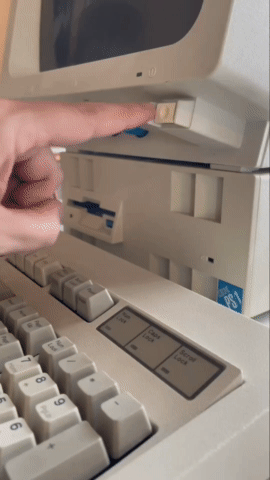
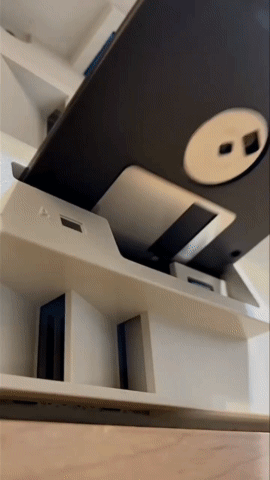
IBM PS/1 Model 2121 (1992)
4K notes
·
View notes
Text
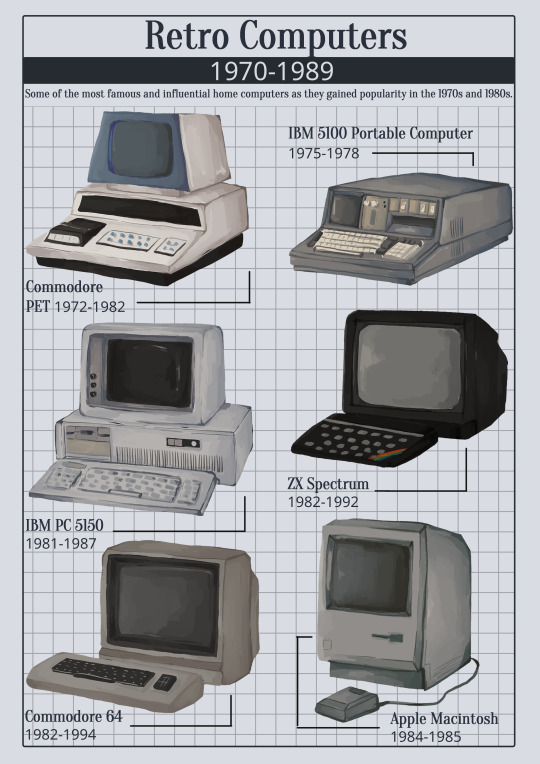
old computers print....i wanted to stick to the most famous and/or iconic ones for the most part but i wanted to include sooo many of my lesser known favourites
#retro tech#old computer#old computers#retro computing#retro computer#vintage computer#vintage tech#commodore 64#commodore pet#apple mac#ibm pc#ibm 5100#macintosh#zx spectrum#80s computer#80s computers
833 notes
·
View notes
Text

623 notes
·
View notes
Photo

IBM System/360
717 notes
·
View notes
Text

IBM 5140 Convertible laptop computer running Microsoft MS-DOS Version 5.00 1986 (x)
#IBM#IBM PC#1986#retro tech#old tech#retro computers#old computers#80s tech#techcore#chromecore#cybercore#vintage tech#laptop
450 notes
·
View notes
Text




PolType/Cyfronex
Polish PolType is a family of microcomputer systems developed by Polish engineers in close cooperation with the Polish representative of the British MonoType company (PolType was acquired by the Cyfronex company in 1986, but the original developers remained with the company).
PolType devices were able to control LaserComp and MonoType Imagesetter machines (Imagesetter produces the printing film from which the printing plate is made – nowadays the plate is made directly, and the film is not needed).
The first generation of Poltype (1988) required its own eight-bit computer, the next, Poltype 03 and 04, used a PC XT class computer.
The 510-key POLSET 04 keyboard (for PolType 04) shown in the first two pictures was also Cyronex's own development. This was also excellent for typing complex mathematical formulas, but through it, the functions of the SW were also available (the mouse and WYSIWYG were still in a very experimental stage at that time)
source:
• Tumbler // sailing the cylindrical sea
• Mikro Klan 1988/1
• Bajtek 1988/5
#poltype#cyfronex#DTP#poland#retrocomputing#retro computing#keyboard#80s#ibm pc#wysiwyg#retro tech#old tech#technology#vintage tech#tech#computer#electronics#hardware#80s computer
233 notes
·
View notes
Text

Just a girl and her IBM 7094 computer.
#ibm#ibm computers#business computers#vintage computers#vintage electronics#ibm 7094#scientific computing#big blue
13 notes
·
View notes
Text

275 notes
·
View notes
Text
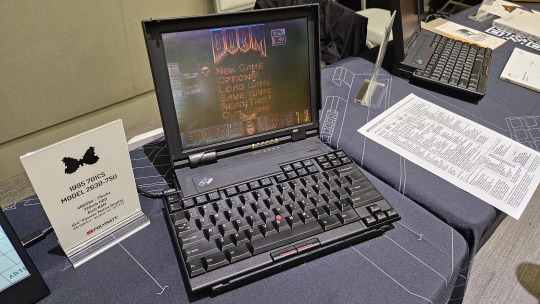
IBM Thinkpad 701CS - the one with the famous butterfly keyboard - VCF Southwest 2023
#ibm thinkpad#vcfsw2023#vcf southwest 2023#vintage computer festival southwest 2023#commodorez goes to vcfsw2023#701c
5K notes
·
View notes
Text

IBM ThinkPad X32 (2005)
1K notes
·
View notes
